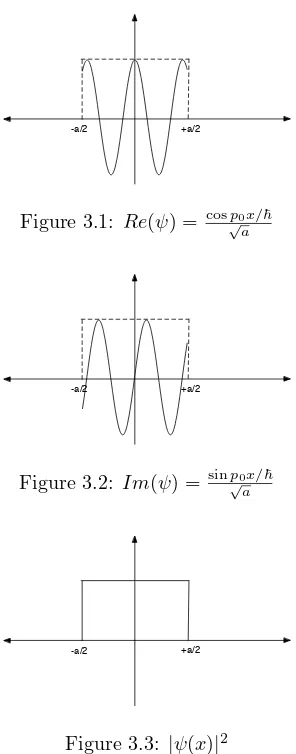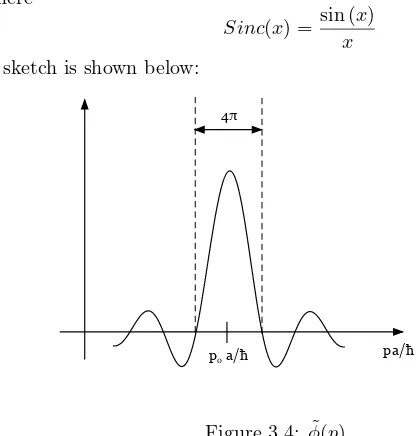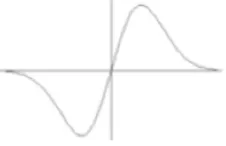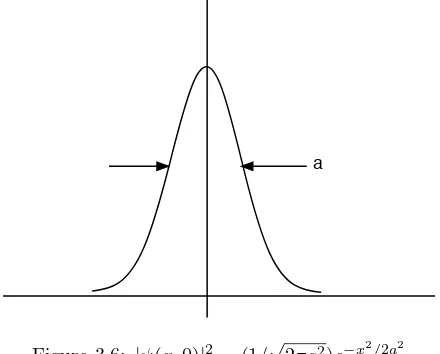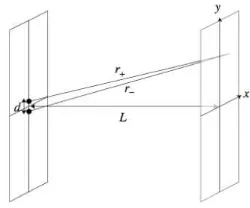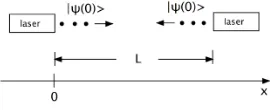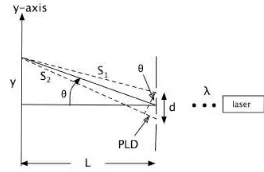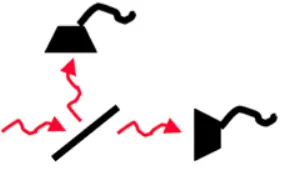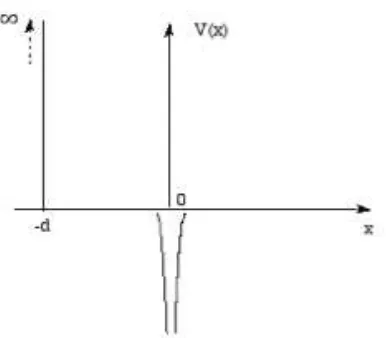Quantum Mechanics
Mathematical Structure
and
Physical Structure
Problems and Solutions
John R. Boccio
Professor of Physics
Swarthmore College
Contents
3
Formulation of Wave Mechanics - Part 2
13.11 Solutions . . . 1
3.11.1 Free Particle in One-Dimension - Wave Functions . . . 1
3.11.2 Free Particle in One-Dimension - Expectation Values . . . 3
3.11.3 Time Dependence . . . 5
3.11.4 Continuous Probability . . . 6
3.11.5 Square Wave Packet . . . 7
3.11.6 Uncertain Dart . . . 10
3.11.7 Find the Potential and the Energy . . . 11
3.11.8 Harmonic Oscillator wave Function . . . 12
3.11.9 Spreading of a Wave Packet . . . 13
3.11.10 The Uncertainty Principle says ... . . 18
3.11.11 Free Particle Schrodinger Equation . . . 19
3.11.12 Double Pinhole Experiment . . . 19
3.11.13 A Falling Pencil . . . 24
4
The Mathematics of Quantum Physics:
Dirac Language
27 4.22 Problems . . . 274.22.1 Simple Basis Vectors . . . 27
4.22.2 Eigenvalues and Eigenvectors . . . 28
4.22.3 Orthogonal Basis Vectors . . . 29
4.22.4 Operator Matrix Representation . . . 30
4.22.5 Matrix Representation and Expectation Value . . . 31
4.22.6 Projection Operator Representation . . . 32
4.22.7 Operator Algebra . . . 33
4.22.8 Functions of Operators . . . 34
4.22.9 A Symmetric Matrix . . . 34
4.22.10 Determinants and Traces . . . 35
4.22.11 Function of a Matrix . . . 36
4.22.12 More Gram-Schmidt . . . 37
4.22.13 Infinite Dimensions . . . 38
4.22.14 Spectral Decomposition . . . 39
ii CONTENTS
4.22.16 Expectation Values . . . 40
4.22.17 Eigenket Properties . . . 41
4.22.18 The World of Hard/Soft Particles . . . 43
4.22.19 Things in Hilbert Space . . . 45
4.22.20 A 2-Dimensional Hilbert Space . . . 47
4.22.21 Find the Eigenvalues . . . 49
4.22.22 Operator Properties . . . 50
4.22.23 Ehrenfest’s Relations . . . 51
4.22.24 Solution of Coupled Linear ODEs . . . 53
4.22.25 Spectral Decomposition Practice . . . 55
4.22.26 More on Projection Operators . . . 57
5
Probability
61 5.6 Problems . . . 615.6.1 Simple Probability Concepts . . . 61
5.6.2 Playing Cards . . . 66
5.6.3 Birthdays . . . 67
5.6.4 Is there life? . . . 68
5.6.5 Law of large Numbers . . . 68
5.6.6 Bayes . . . 69
5.6.7 Psychological Tests . . . 70
5.6.8 Bayes Rules, Gaussians and Learning . . . 71
5.6.9 Berger’s Burgers-Maximum Entropy Ideas . . . 74
5.6.10 Extended Menu at Berger’s Burgers . . . 77
5.6.11 The Poisson Probability Distribution . . . 79
5.6.12 Modeling Dice: Observables and Expectation Values . . . 85
5.6.13 Conditional Probabilities for Dice . . . 87
5.6.14 Matrix Observables for Classical Probability . . . 88
6
The Formulation of Quantum Mechanics
91
6.19 Problems . . . 916.19.1 Can It Be Written? . . . 91
6.19.2 Pure and Nonpure States . . . 92
6.19.3 Probabilities . . . 94
6.19.4 Acceptable Density Operators . . . 96
6.19.5 Is it a Density Matrix? . . . 97
6.19.6 Unitary Operators . . . 97
6.19.7 More Density Matrices . . . 99
6.19.8 Scale Transformation . . . 101
6.19.9 Operator Properties . . . 102
6.19.10 An Instantaneous Boost . . . 103
6.19.11 A Very Useful Identity . . . 105
6.19.12 A Very Useful Identity with some help.... . . 106
6.19.13 Another Very Useful Identity . . . 108
CONTENTS iii
6.19.15 Schur’s Lemma . . . 110
6.19.16 More About the Density Operator . . . 112
6.19.17 Entanglement and the Purity of a Reduced Density Op-erator . . . 114
6.19.18 The Controlled-Not Operator . . . 115
6.19.19 Creating Entanglement via Unitary Evolution . . . 116
6.19.20 Tensor-Product Bases . . . 117
6.19.21 Matrix Representations . . . 118
6.19.22 Practice with Dirac Language for Joint Systems . . . 121
6.19.23 More Mixed States . . . 123
6.19.24 Complete Sets of Commuting Observables . . . 125
6.19.25 Conserved Quantum Numbers . . . 126
7
How Does It really Work:
Photons, K-Mesons and Stern-Gerlach
127
7.5 Problems . . . 1277.5.1 Change the Basis . . . 127
7.5.2 Polaroids . . . 128
7.5.3 Calcite Crystal . . . 129
7.5.4 Turpentine . . . 129
7.5.5 What QM is all about - Two Views . . . 130
7.5.6 Photons and Polarizers . . . 134
7.5.7 Time Evolution . . . 135
7.5.8 K-Meson oscillations . . . 136
7.5.9 What comes out? . . . 138
7.5.10 Orientations . . . 139
7.5.11 Find the phase angle . . . 140
7.5.12 Quarter-wave plate . . . 143
7.5.13 What is happening? . . . 144
7.5.14 Interference . . . 145
7.5.15 More Interference . . . 146
7.5.16 The Mach-Zender Interferometer and Quantum Interference147 7.5.17 More Mach-Zender . . . 153
8
Schrodinger Wave equation
1-Dimensional Quantum Systems
155
8.15 Problems . . . 1558.15.1 Delta function in a well . . . 155
8.15.2 Properties of the wave function . . . 156
8.15.3 Repulsive Potential . . . 157
8.15.4 Step and Delta Functions . . . 159
8.15.5 Atomic Model . . . 160
8.15.6 A confined particle . . . 164
iv CONTENTS
8.15.8 Using the commutator . . . 166
8.15.9 Matrix Elements for Harmonic Oscillator . . . 168
8.15.10 A matrix element . . . 169
8.15.11 Correlation function . . . 170
8.15.12 Instantaneous Force . . . 171
8.15.13 Coherent States . . . 172
8.15.14 Oscillator with Delta Function . . . 174
8.15.15 Measurement on a Particle in a Box . . . 177
8.15.16 Aharonov-Bohm experiment . . . 183
8.15.17 A Josephson Junction . . . 186
8.15.18 Eigenstates using Coherent States . . . 189
8.15.19 Bogliubov Transformation . . . 190
8.15.20 Harmonic oscillator . . . 192
8.15.21 Another oscillator . . . 193
8.15.22 The coherent state . . . 194
8.15.23 Neutrino Oscillations . . . 200
8.15.24 Generating Function . . . 205
8.15.25 Given the wave function ... . . . 207
8.15.26 What is the oscillator doing? . . . 208
8.15.27 Coupled oscillators . . . 210
8.15.28 Interesting operators .... . . 210
8.15.29 What is the state? . . . 212
8.15.30 Things about particles in box . . . 213
8.15.31 Handling arbitrary barriers... . . . 214
8.15.32 Deuteron model . . . 217
8.15.33 Use Matrix Methods . . . 219
8.15.34 Finite Square Well Encore . . . 220
8.15.35 Half-Infinite Half-Finite Square Well Encore . . . 224
8.15.36 NuclearαDecay . . . 229
8.15.37 One Particle, Two Boxes . . . 231
8.15.38 A half-infinite/half-leaky box . . . 236
8.15.39 Neutrino Oscillations Redux . . . 239
8.15.40 Is it in the ground state? . . . 242
8.15.41 Some Thoughts on T-Violation . . . 243
8.15.42 Kronig-Penney Model . . . 246
8.15.43 Operator Moments and Uncertainty . . . 254
8.15.44 Uncertainty and Dynamics . . . 255
9
Angular Momentum; 2- and 3-Dimensions 259
9.7 Problems . . . 2599.7.1 Position representation wave function . . . 259
9.7.2 Operator identities . . . 260
9.7.3 More operator identities . . . 261
9.7.4 On a circle . . . 263
CONTENTS v
9.7.6 A Wave Function . . . 265
9.7.7 L= 1 System . . . 265
9.7.8 A Spin-3/2 Particle . . . 268
9.7.9 Arbitrary directions . . . 272
9.7.10 Spin state probabilities . . . 276
9.7.11 A spin operator . . . 277
9.7.12 Simultaneous Measurement . . . 278
9.7.13 Vector Operator . . . 280
9.7.14 Addition of Angular Momentum . . . 281
9.7.15 Spin = 1 system . . . 282
9.7.16 Deuterium Atom . . . 287
9.7.17 Spherical Harmonics . . . 288
9.7.18 Spin in Magnetic Field . . . 289
9.7.19 What happens in the Stern-Gerlach box? . . . 296
9.7.20 Spin = 1 particle in a magnetic field . . . 297
9.7.21 Multiple magnetic fields . . . 298
9.7.22 Neutron interferometer . . . 299
9.7.23 Magnetic Resonance . . . 302
9.7.24 More addition of angular momentum . . . 306
9.7.25 Clebsch-Gordan Coefficients . . . 308
9.7.26 Spin−1/2 and Density Matrices . . . 309
9.7.27 System ofN Spin−1/2 Particle . . . 311
9.7.28 In a coulomb field . . . 312
9.7.29 Probabilities . . . 312
9.7.30 What happens? . . . 314
9.7.31 Anisotropic Harmonic Oscillator . . . 315
9.7.32 Exponential potential . . . 317
9.7.33 Bouncing electrons . . . 320
9.7.34 Alkali Atoms . . . 322
9.7.35 Trapped between . . . 323
9.7.36 Logarithmic potential . . . 324
9.7.37 Spherical well . . . 325
9.7.38 In magnetic and electric fields . . . 328
9.7.39 Extra(Hidden) Dimensions . . . 329
9.7.40 Spin−1/2 Particle in a D-State . . . 339
9.7.41 Two Stern-Gerlach Boxes . . . 340
9.7.42 A Triple-Slit experiment with Electrons . . . 341
9.7.43 Cylindrical potential . . . 342
9.7.44 Crazy potentials... . . . 345
9.7.45 Stern-Gerlach Experiment for a Spin-1 Particle . . . 347
9.7.46 Three Spherical Harmonics . . . 348
9.7.47 Spin operators ala Dirac . . . 350
9.7.48 Another spin = 1 system . . . 351
9.7.49 Properties of an operator . . . 352
9.7.50 Simple Tensor Operators/Operations . . . 354
vi CONTENTS
9.7.52 Spin Projection Operators . . . 356
9.7.53 Two Spins in a magnetic Field . . . 357
9.7.54 Hydrogen d States . . . 359
9.7.55 The Rotation Operator for Spin−1/2 . . . 360
9.7.56 The Spin Singlet . . . 362
9.7.57 A One-Dimensional Hydrogen Atom . . . 364
9.7.58 Electron in Hydrogenp−orbital . . . 365
9.7.59 Quadrupole Moment Operators . . . 372
9.7.60 More Clebsch-Gordon Practice . . . 375
9.7.61 Spherical Harmonics Properties . . . 383
9.7.62 Starting Point for Shell Model of Nuclei . . . 387
9.7.63 The Axial-Symmetric Rotor . . . 395
9.7.64 Charged Particle in 2-Dimensions . . . 398
9.7.65 Particle on a Circle Again . . . 408
9.7.66 Density Operators Redux . . . 411
9.7.67 Angular Momentum Redux . . . 412
9.7.68 Wave Function Normalizability . . . 415
9.7.69 Currents . . . 416
9.7.70 Pauli Matrices and the Bloch Vector . . . 417
10
Time-Independent Perturbation Theory
419
10.9 Problems . . . 41910.9.1 Box with aSagging Bottom . . . 419
10.9.2 Perturbing the Infinite Square Well . . . 420
10.9.3 Weird Perturbation of an Oscillator . . . 421
10.9.4 Perturbing the Infinite Square Well Again . . . 423
10.9.5 Perturbing the 2-dimensional Infinite Square Well . . . . 424
10.9.6 Not So Simple Pendulum . . . 426
10.9.7 1-Dimensional Anharmonic Oscillator . . . 427
10.9.8 A Relativistic Correction for Harmonic Oscillator . . . 429
10.9.9 Degenerate perturbation theory on a spin = 1 system . . 430
10.9.10 Perturbation Theory in Two-Dimensional Hilbert Space . 431 10.9.11 Finite Spatial Extent of the Nucleus . . . 435
10.9.12 Spin-Oscillator Coupling . . . 438
10.9.13 Motion in spin-dependent traps . . . 440
10.9.14 Perturbed Oscillator . . . 443
10.9.15 Another Perturbed Oscillator . . . 444
10.9.16 Helium from Hydrogen - 2 Methods . . . 446
10.9.17 Hydrogen atom + xy perturbation . . . 449
10.9.18 Rigid rotator in a magnetic field . . . 451
10.9.19 Another rigid rotator in an electric field . . . 453
10.9.20 A Perturbation with 2 Spins . . . 454
10.9.21 Another Perturbation with 2 Spins . . . 456
10.9.22 Spherical cavity with electric and magnetic fields . . . 458
CONTENTS vii
10.9.24n= 3 Stark effect in Hydrogen . . . 463
10.9.25 Perturbation of the n= 3 level in Hydrogen - Spin-Orbit and Magnetic Field corrections . . . 466
10.9.26 Stark Shift in Hydrogen with Fine Structure . . . 477
10.9.27 2-Particle Ground State Energy . . . 482
10.9.28 1s2s Helium Energies . . . 484
10.9.29 Hyperfine Interaction in the Hydrogen Atom . . . 485
10.9.30 Dipole Matrix Elements . . . 487
10.9.31 Variational Method 1 . . . 489
10.9.32 Variational Method 2 . . . 494
10.9.33 Variational Method 3 . . . 495
10.9.34 Variational Method 4 . . . 496
10.9.35 Variation on a linear potential . . . 497
10.9.36 Average Perturbation is Zero . . . 499
10.9.37 3-dimensional oscillator and spin interaction . . . 500
10.9.38 Interacting with the Surface of Liquid Helium . . . 501
10.9.39 Positronium + Hyperfine Interaction . . . 502
10.9.40 Two coupled spins . . . 504
10.9.41 Perturbed Linear Potential . . . 508
10.9.42 The ac-Stark Effect . . . 509
10.9.43 Light-shift for multilevel atoms . . . 516
10.9.44 A Variational Calculation . . . 525
10.9.45 Hyperfine Interaction Redux . . . 526
10.9.46 Find a Variational Trial Function . . . 528
10.9.47 Hydrogen Corrections on 2s and 2p Levels . . . 535
10.9.48 Hyperfine Interaction Again . . . 539
10.9.49 A Perturbation Example . . . 542
10.9.50 More Perturbation Practice . . . 544
11
Time-Dependent Perturbation Theory
547
11.5 Problems . . . 54711.5.1 Square Well Perturbed by an Electric Field . . . 547
11.5.2 3-Dimensional Oscillator in an electric field . . . 549
11.5.3 Hydrogen in decaying potential . . . 550
11.5.4 2 spins in a time-dependent potential . . . 551
11.5.5 A Variational Calculation of the Deuteron Ground State Energy . . . 553
11.5.6 Sudden Change - Don’t Sneeze . . . 556
11.5.7 Another Sudden Change - Cutting the spring . . . 557
11.5.8 Another perturbed oscillator . . . 558
11.5.9 Nuclear Decay . . . 559
11.5.10 Time Evolution Operator . . . 562
11.5.11 Two-Level System . . . 562
11.5.12 Instantaneous Force . . . 563
viii CONTENTS
11.5.14 Particle in a Delta Function and an Electric Field . . . . 565
11.5.15 Nasty time-dependent potential [complex integration needed]569 11.5.16 Natural Lifetime of Hydrogen . . . 570
11.5.17 Oscillator in electric field . . . 573
11.5.18 Spin Dependent Transitions . . . 574
11.5.19 The Driven Harmonic Oscillator . . . 579
11.5.20 A Novel One-Dimensional Well . . . 581
11.5.21 The Sudden Approximation . . . 582
11.5.22 The Rabi Formula . . . 584
11.5.23 Rabi Frequencies in Cavity QED . . . 585
12
Identical Particles
589
12.9 Problems . . . 58912.9.1 Two Bosons in a Well . . . 589
12.9.2 Two Fermions in a Well . . . 590
12.9.3 Two spin−1/2 particles . . . 592
12.9.4 Hydrogen Atom Calculations . . . 595
12.9.5 Hund’s rule . . . 599
12.9.6 Russell-Saunders Coupling in Multielectron Atoms . . . . 600
12.9.7 Magnetic moments of proton and neutron . . . 603
12.9.8 Particles in a 3-D harmonic potential . . . 605
12.9.9 2 interacting particles . . . 608
12.9.10 LS versus JJ coupling . . . 610
12.9.11 In a harmonic potential . . . 612
12.9.12 2 particles interacting via delta function . . . 614
12.9.13 2 particles in a square well . . . 616
12.9.14 2 particles interacting via a harmonic potential . . . 617
12.9.15 The Structure of helium . . . 619
13
Scattering Theory and Molecular Physics 623
13.3 Problems . . . 62313.3.1 S-Wave Phase Shift . . . 623
13.3.2 Scattering Slow Particles . . . 625
13.3.3 Inverse square scattering . . . 626
13.3.4 Ramsauer-Townsend Effect . . . 629
13.3.5 Scattering from a dipole . . . 630
13.3.6 Born Approximation Again . . . 631
13.3.7 Translation invariant potential scattering . . . 632
13.3.8 ℓ= 1 hard sphere scattering . . . 632
13.3.9 Vibrational Energies in a Diatomic Molecule . . . 634
13.3.10 Ammonia Molecule . . . 635
13.3.11 Ammonia molecule Redux . . . 637
13.3.12 Molecular Hamiltonian . . . 638
13.3.13 Potential Scattering from a 3D Potential Well . . . 640
CONTENTS ix
13.3.15 Green’s Function . . . 646
13.3.16 Scattering from a Hard Sphere . . . 649
13.3.17 Scattering from a Potential Well . . . 650
13.3.18 Scattering from a Yukawa Potential . . . 653
13.3.19 Born approximation - Spin-Dependent Potential . . . 654
13.3.20 Born approximation - Atomic Potential . . . 656
13.3.21 Lennard-Jones Potential . . . 657
13.3.22 Covalent Bonds - Diatomic Hydrogen . . . 661
13.3.23 Nucleus as sphere of charge - Scattering . . . 663
15
States and Measurement
667 15.6 Problems . . . 66715.6.1 Measurements in a Stern-Gerlach Apparatus . . . 667
15.6.2 Measurement in 2-Particle State . . . 670
15.6.3 Measurements on a 2 Spin-1/2 System . . . 671
15.6.4 Measurement of a Spin-1/2 Particle . . . 673
15.6.5 Mixed States vs. Pure States and Interference . . . 677
15.6.6 Which-path information, Entanglement, and Decoherence 680 15.6.7 Livio and Oivil . . . 684
15.6.8 Measurements on Qubits . . . 688
15.6.9 To be entangled.... . . 690
15.6.10 Alice, Bob and Charlie . . . 691
16
The EPR Argument and Bell Inequality
695 16.10Problems . . . 69516.10.1 Bell Inequality with Stern-Gerlach . . . 695
16.10.2 Bell’s Theorem with Photons . . . 699
16.10.3 Bell’s Theorem with Neutrons . . . 704
16.10.4 Greenberger-Horne-Zeilinger State . . . 706
17
Path Integral Methods
711 17.7 Problems . . . 71117.7.1 Path integral for a charged particle moving on a plane in the presence of a perpendicular magnetic field . . . 711
17.7.2 Path integral for the three-dimensional harmonic oscillator 712 17.7.3 Transitions in the forced one-dimensional oscillator . . . . 712
17.7.4 Green’s Function for a Free Particle . . . 713
17.7.5 Propagator for a Free Particle . . . 713
18
Solid State Physics
715 18.7 Problems . . . 71518.7.1 Piecewise Constant Potential Energy One Atom per Primitive Cell . . . 715
x CONTENTS
18.7.3 Free-Electron Energy Bands for a Crystal with a Primitive
Rectangular Bravais Lattice . . . 716
18.7.4 Weak-Binding Energy Bands for a Crystal with a Hexag-onal Bravais Lattice . . . 717
18.7.5 A Weak-Binding Calculation #1 . . . 718
18.7.6 Weak-Binding Calculations with Delta-Function Potential Energies . . . 719
19
Second Quantization
721 19.9 Problems . . . 72119.9.1 Bogoliubov Transformations . . . 721
19.9.2 Weakly Interacting Bose gas in the Bogoliubov Approxi-mation . . . 721
19.9.3 Problem 19.9.2 Continued . . . 722
19.9.4 Mean-Field Theory, Coherent States and the Grtoss-Pitaevkii Equation . . . 723
19.9.5 Weakly Interacting Bose Gas . . . 724
19.9.6 Bose Coulomb Gas . . . 724
19.9.7 Pairing Theory of Superconductivity . . . 724
19.9.8 Second Quantization Stuff . . . 725
19.9.9 Second Quantized Operators . . . 727
19.9.10 Working out the details in Section 19.8 . . . 727
20
Relativistic Wave Equations
Electromagnetic Radiation in Matter
729 20.8 Problems . . . 72920.8.1 Dirac Spinors . . . 729
20.8.2 Lorentz Transformations . . . 729
20.8.3 Dirac Equation in 1 + 1 Dimensions . . . 730
20.8.4 Trace Identities . . . 730
20.8.5 Right- and Left-Handed Dirac Particles . . . 730
20.8.6 Gyromagnetic Ratio for the Electron . . . 731
20.8.7 Dirac→Schrodinger . . . 731
20.8.8 Positive and Negative Energy Solutions . . . 731
20.8.9 Helicity Operator . . . 732
20.8.10 Non-Relativisitic Limit . . . 732
20.8.11 Gyromagnetic Ratio . . . 732
20.8.12 Properties ofγ5. . . 732
20.8.13 Lorentz and Parity Properties . . . 732
20.8.14 A Commutator . . . 733
20.8.15 Solutions of the Klein-Gordon equation . . . 733
20.8.16 Matrix Representation of Dirac Matrices . . . 733
20.8.17 Weyl Representation . . . 734
20.8.18 Total Angular Momentum . . . 734
Chapter 3
Formulation of Wave Mechanics - Part 2
3.11
Solutions
3.11.1
Free Particle in One-Dimension - Wave Functions
since ˜ψ(p, t) is an eigenfunction ofH (only 1pvalue). This implies that
where we have used Z
∞
−∞
e−y2dy=√π
(d) Show that thespread in the spatial probability distribution
℘(x, t) = |ψ(x, t)|
2
hψ(t)|ψ(t)i increases with time.
The important terms are 1
q
σ2+it~
2m
→amplitude decreases with time
and
e−
(x−x0−2ip0σ2/~)2 4(σ2 +it~
2m) →width(spread) increases with time
3.11.2
Free Particle in One-Dimension - Expectation
Val-ues
For a free particle in one-dimension
H = p
2
2m
(a) Showhpxi=hpxit=0
dhpxi
dt =
1
i~h[px, H]i= 0→ hpxit=hpxi0
(b) Showhxi=hhpxit=0
m
i
t+hxit=0
d dthxi=
1
i~h[x, H]i=
1 2im~h[x, p
2
x]i=
1
mhpxi=
1
mhpxi0
Therefore
hxit=
1
mhpxi0t+hxi0
(c) Show (∆px)2= (∆px)2t=0
d dthp
2
xi= 1
i~h[p 2
x, H]i= 0→ hp2xit=hp2xi0
Therefore
(∆px)2t =hp2xit− hpxi2t =hp2xi0− hpxi20= (∆px)20
(d) Find (∆x)2as a function of time and initial conditions. HINT: Find
d dt
x2
To solve the resulting differential equation, one needs to know the time dependence ofhxpx+pxxi. Find this by considering
d
We have
We then get
d
where we have used the result from part (c). Therefore,
which implies that
3.11.3
Time Dependence
Given
where we have used hermiticity in the last step.
(d) Find dtd hHi
d dthHi=
1
i~h[H, H]i= 0
(e) Finddtd hLziand compare with the corresponding classical equation
~
L=~x×p~
Classically we have
d~L
Quantum Mechanically, we have
d
which is the same equation!
3.11.4
Continuous Probability
Ifp(x) =xe−x/λis the probability density function over the interval 0< x <∞, find the mean, standard deviation and most probable value(where probability density is maximum) ofx.
The mean value ofxis
The standard deviation is defined by
The probability density is an extremum when
p′(x) =e−x/λ
−xλe−x/λ= 0 (3.1)
at x=λor as x→ ∞. Note thatλ >0 ifp(x) is to be finite in 0< x < ∞. Since
p′′(x) =−2
λe
−x/λ+ x
λ2e−
x/λ
We have
p′′(λ) =−λ1e−1<0 , lim
x→∞p
′′(x) = 0
the probability density is a maximum atx=λHence, the most probable value ofxisλ.
3.11.5
Square Wave Packet
Consider a free particle, initially with a well-defined momentump0, whose wave
function is well approximated by a plane wave. Att= 0, the particle is localized in a region−a/2≤x≤a/2, so that its wave function is
ψ(x) =
(
Aeip0x/~ −a/2≤x≤a/2
0 otherwise
(a) Find the normalization constant A and sketch Re(ψ(x)), Im(ψ(x)) and
|ψ(x)|2
The normalization integral is
Z ∞
−∞|
ψ(x))|2dx=
Z a/2 −a/2|
A|2dx=a|A|2= 1→A= e
iφ √a
where the overall phaseφis arbitrary. We setφ= 0 from now on. There-fore we have
ψ(x) =
( 1
√
ae
ip0x/~ −a/2≤x≤a/2
0 otherwise
-a/2 +a/2
Figure 3.1: Re(ψ) = cosp0x/~ √
a
-a/2 +a/2
Figure 3.2: Im(ψ) = sin√p0x/~
a
-a/2 +a/2
Figure 3.3: |ψ(x)|2
Note that the probability density in position space does not depend on the momentum p0.
(b) Find the momentum space wave function ˜ψ(p) and show that it too is normalized. The momentum space wave function is given by
˜
φ(p) =√1
2π~
Z ∞
−∞
ψ(x)e−ipx/~
dx= √ 1
2π~a
Z a/2 −a/2
ψ(x)e−i(p−p0)x/~dx
= √ 1
2π~a
~
−i(p−p0)
a/2 −a/2
= 2√ 1
2π~a
sin(p−p0)
~
a
2
(p−p0)
~
Thus,
˜
φ(p) =
r a
2π~Sinc
(p−p0)a
2~
where
Sinc(x) = sin (x)
x
A sketch is shown below:
pa/ħ p0 a/ħ
4π
Figure 3.4: ˜φ(p)
Note the phase-shift duality. The normalization of the momentum space wave function is given by
Z ∞
−∞|
˜
φ(p)|2dp= 1 2π
Z ∞
−∞
a
~Sinc 2
(p−p0)a
2~
= 1 2π
Z ∞
−∞
Sinc2
(y−y0)
2
dy= 1
where we have substitutedy=pa/~and the result
Z ∞
−∞
Sinc2
(y
−y0)
2
dy= 2π
So, as expected, given a normalized ψ(x), ˜φ(p) will also be normalized. This is just a theorem from Fourier transforms.
(c) Find the uncertainties ∆xand ∆pat this time. How close is this to the minimum uncertainty wave function.
We can estimate ∆xand ∆pby eyelooking at the probability distributions
|ψ(x)|2 and|φ˜(p)|2.
Clearly, ∆x≈a. If we take ∆pto be the width indicated in the last figure, i.e., ∆p≈4π~/a, then we get
∆x∆p≈4π~
which is not quite minimum uncertainty. Formally calculating, we have
withhxi= 0 by inspection and
hx2i=
Z ∞
−∞
x2|ψ(x)|2dx=Z a/2 −a/2
x2
a = a2
12 →∆x=
a
√
12
We also have
∆x=php2i − hpi2
withhpi=p0 by inspection and
hp2i=
Z ∞
−∞
p2|φ˜(p)|2dp=
Z ∞
−∞
p2dp
~
sin2(p−p0)a/2)
(p−p0)2
=∞!!!!
This implies that ∆p=∞!!!. The formal variance diverges!. What hap-pened? It is because of the discontinuity in |ψ(x)|2, which via Fourier
transforms then requires all values ofpto be included. This is not physi-cal!!
3.11.6
Uncertain Dart
A dart of mass 1kg is dropped from a height of 1m, with the intention to hit a certain point on the ground. Estimate the limitation set by the uncertainty principle of the accuracy that can be achieved.
For simplicity, we will consider only motion in thex−y plane (y vertical andx
horizontal). If there was no uncertainty principle, then a dart released from a heighthabove the pointx= 0 would strike the pointx= 0 since we can set both
x(0) = 0 andvx(0) = 0 initially. Quantum mechanics does not let us do this,
however. Assume thaty(0) = h= 1m and vy(0) = 0 for the vertical motion.
Any uncertainty principle effects will be negligible in the vertical direction. We also assume that x(0) = ∆x and vx(0) = px(0)/m= px(0) = ∆p, where
∆x∆p≈~. We then have the following equations of motion:
y(t) =y(0) +vy(0)t−
1 2gt
2=h
−12gt2
x(t) =x(0) +vx(0)t= ∆x+ ∆p t→t=
x−∆x
∆p
We then have
y=h−1
2g
x−∆x
∆p 2
We are interested in finding the minimum value of x when y = 0 (hits the ground). Substitutingy= 0,h= 1m, g= 10m/sec2, ∆p=~/∆xand solving
forxwe get
x= ∆x+0.45~
We find the minimum by computing
∂x
∂∆x= 0 = 1−
0.45~
(∆x)2 →∆x=
√
0.45~
Therefore, the minimum xconsistent with quantum mechanics is
xmin= 2 √
0.45~≈10−17m
This is a very small distance! An atomic nucleus has a diameter of 10−15m.
3.11.7
Find the Potential and the Energy
Suppose that the wave function of a (spinless) particle of massmis
ψ(r, θ, φ) =Ae−
αr−e−βr
r
where A, α and β are constants such that 0 < α < β. Find the potential
V(r, θ, φ) and the energyE of the particle.
Write the wave function as
ψ(r, θ, φ) =Ae−
αr −e−βr
r =
u(r)
r
Since ψdepends only on r, we haveℓ=m= 0, and the Schrodinger equation in spherical coordinates is
−~
2
2m d2u
dr2 + (V(r)−E)u= 0→V(r)−E = ~2
2m
1
u d2u
dr2
Differentiateu(r) =A(e−αr
−e−βr):
du
dr =A(−αe
−αr+βe−βr) , d2u
dr2 =A(α 2e−αr
−β2e−βr)
This gives
V(r)−E= ~
2
2m α2e−αr
−β2e−βr
e−αr−e−βr
Since the potential must vanish at r→ ∞, we get
E=− lim
r→∞ ~2
2m α2e−αr
−β2e−βr
e−αr−e−βr =−
~2α2
2m
and the potential is
V(r) = ~
2
2m
α2e−αr−β2e−βr
e−αr−e−βr −α
2
For smallr:
V(r)≈ −~
2
2m
(α2
−β2)e−βr
(β−α)r =−
~2(α+β)e−βr
2mr
This is a screened Coulomb potential.
The same procedure to findV,Ealso works ifψhas an angular dependence, by including the centrifugal barrier termℓ(ℓ+ 1)~2/2mr2in the radial Schrodinger
equation.
3.11.8
Harmonic Oscillator wave Function
In a harmonic oscillator a particle of massm and frequency ω is subject to a parabolic potentialV(x) =mω2x2/2. One of the energy eigenstates isu
n(x) =
Axe(−x2/x2
0), as sketched below.
Figure 3.5: A Wave Function
(a) Is this the ground state, the first excited state, second excited state, or third?
The plot shows one node which implies that it is the first excited state. Alternatively, the Schrodinger equation
−~
2
2m d2ψ
dx2 +V(x)ψ=Eψ , V(x) =
1 2mω
2x2
gives
− ~
2
2m d dx
Ae(−x2/x20)−2x 2
x2 0
Ae(−x2/x20)
+V(x)ψ=Eψ
− ~
2
2m
−x62 0
+4x
2
x4 0
ψ+1
2mω
2x2ψ=Eψ
Taking limx→∞says that we must have
4~2x2
2mx4 0
= 1 2mω
2
→x20=
2~
We then have
E=−~
2
2m
−x62 0
=3 2~ω which corresponds to the first excited state energy.
(b) Is this an eigenstate of parity?
We have using the parity operator ˆP
ˆ
Pψ(x) = ˆP(Axe(−x2/x20)) =A(−x)e(−(−x)2/x20)=−Axe(−x2/x20)=−ψ(x)
Therefore, it is an eigenstate of ˆP with eigenvalue−1.
(c) Write an integral expression for the constant A that makesun(x) a
nor-malized state. Evaluate the integral.
We have
1 =
Z ∞
−∞|
ψ|2dx=A2Z ∞ −∞
x2e(−2x2/x20)dx
Changing variables withy=√2x/x0, we get
1 =A2 x
3 0
2√2
Z ∞
−∞
y2e−y2dy
Using
Z ∞
−∞
y2e−y2dy=
√π
2 we get
1 =A2 x
3 0
2√2
√
π
2 →A
2=
r
2
π
4
x3 0
3.11.9
Spreading of a Wave Packet
A localized wave packet in free space will spread due to its initial distribution of momenta. This wave phenomenon is known as dispersion, arising because the relation between frequency ω and wavenumber k is not linear. Let us look at this in detail.
Consider a general wave packet in free space at timet= 0,ψ(x,0).
(a) Show that the wave function at a later time is
ψ(x, t) =
Z ∞
−∞
dx′K(x, x′;t)ψ(x′)
where
K(x, x′;t) =
r m
2πi~texp
im(x−x′)2
2~t
is known as thepropagator. [HINT: Solve the initial value problem in the usual way - Decompose ψ(x,0) into stationary states (here plane waves), add the time dependence and then re-superpose].
For a general wave packet we have
ψ(x,0) = √1
2π Z ∞
−∞
b(k)eikxdk=√1
2π Z ∞
−∞
φ(k;x)dk
i.e., an infinite superposition of planes waves (free-space stationary states) with arbitrary coefficients, b(k). Including the coefficients b(k) given by the Fourier transform relation
b(k) = √1
2π Z ∞
−∞
ψ(x,0)e−ikxdx
in the stationary stateφ(k;x) gives the last integral above.
But we know the time dependence of the stationary states φ(k;x) from the time-dependent Schrodinger equation
i~d
dtφ(k;x, t) = ˆHφ(k;x, t)
with ˆH = ˆp2/2mfor free space. This implies that
φ(k;x, t) =φ(k;x,0)e−iωt
where ω=ω(k) is given by
E=~ω(k) =~ 2k2
2m
Since we know the time dependence of the individual terms in the integral, we just integrate to get the overall time dependence which is then not
stationary
ψ(x, t) =√1
2π Z ∞
−∞
φ(k;x, t)dk=√1
2π Z ∞
−∞
b(k)ei(kx−ω(k)t)dk
We then have
b(k) =√1
2π Z ∞
−∞
ψ(x′,0)e−ikx′dx′
ψ(x, t) = √1
2π Z ∞
−∞
φ(k;x, t)dk=√1
2π Z ∞
−∞
1
√
2π Z ∞
−∞
ψ(x′,0)e−ikx′dx′
ei(kx−ω(k)t)dk
=
Z ∞
−∞
dx′ψ(x′,0)
Z ∞
−∞
dk
2πe
We then define
as the Free Space Propagator. We can evaluate the propagator by com-pleting the square withω=~k2/2m. Using
A2k2+ 2ABk(x−x′) +B2(x−x′)2= ~t 2mk
2
−k(x−x′) +B2(x−x′)2
we require that
A2= ~t
2m , 2AB=−1 , B
2= m
2~t
and the expression forK becomes
K(x, x′, t) =
where we have used
Z ∞
(b) Suppose the initial wave packet is a Gaussian
ψ(x,0) = 1 (2πa2)1/4e
ik0xe−x2/4a2
Show that it is normalized.
The normalization condition is
(c) Given the characteristic width a, find the characteristic momentum pc,
energy Ec and the time scale tc associated with the packet. The timetc
sets the scale at which the packet will spread. Find this for a macroscopic object of mass 1g and widtha= 1cm. Comment.
The probability distribution looks like:
a
Figure 3.6: |ψ(x,0)|2= (1/√2πa2)e−x2/2a2
The width agives us an estimate of ∆xat t = 0. Since this is the only length in the problem, we take it as one of ourcharacteristic lengths,xc
xc ≡a≈∆x
The Heisenberg uncertainty principle gives
∆x∆p≥~
so we take the minimum momentum uncertainty att= 0 for our charac-teristic momentum,
pc= ∆pmin(t= 0) =
~
∆x(t= 0 =
~
xc
=~
a
We thus have the characteristic energy
Ec=
p2
c
2m =
~2
2ma2
Associated with any characteristic energy is a characteristic time
tc
~
Ec
=2ma
2
~
Form= 1gm,a= 1cm, we havet+c≈2×1027sec. This is much larger
(d) Show that the wave packet probability density remains Gaussian with the
Using part (a)
ψ(x, t) =
We now complete the square as before.
A2x′2+ 2ABx′+B2=
We then have
A2=
We then have
Thus,
Finally we get
|ψ|2= p 1
3.11.10
The Uncertainty Principle says ...
Show that, for the 1-dimensional wavefunction
ψ(x) =
(
(2a)−1/2
|x|< a
0 |x|> a
the rms uncertainty in momentum is infinite (HINT: you need to Fourier trans-formψ). Comment on the relation of this result to the uncertainty principle.
We have
Therefore,hpi= 0 by inspection and
hp2i=
Z ∞
−∞
p2|φ˜(p)|2dp=∞
3.11.11
Free Particle Schrodinger Equation
The time-independent Schrodinger equation for a free particle is given by
1 2m
~
i ∂ ∂~x
2
ψ(~x) =Eψ(~x)
It is customary to write E=~2k2/2mto simplify the equation to
∇2+k2ψ(~x) = 0
Show that
(a) a plane waveψ(~x) =eikz
and
(b) a spherical waveψ(~x) =eikr/r(r=px2+y2+z2)
satisfy the equation.
(a) For a plane waveψ(~x) =eikz
∇2ψ(~x) = d2
dz2e
ikz=
−k2eikz
and we clearly have a solution.
and
(b) For a spherical waveψ(~x) =eikr/r(r=px2+y2+z2)
∇2ψ(~x) = 1
r2
d dr
r2 d
dr
eikr
r =
1
r2
d dr −e
ikr+ikreikr
=−k2ψ(~x)
and we clearly have a solution.
Note that in either case, the wavelength of the solution is given by λ= 2π/k
and the momentum by the de Broglie relationp=~k.
3.11.12
Double Pinhole Experiment
Figure 3.7: The Double Pinhole Setup
Suppose you send in an electron along thez−axis onto a screen atz= 0 with two pinholes atx= 0, y=±d/2. At a point (x, y) on another screen atz=L≫d, λ
the distance from each pinhole is given byr±=px2+ (y∓d/2)2+L2.
The spherical waves from each pinhole are added at the point on the screen and hence the wave function is
ψ(x, y) = e
ikr+ r+
+e
ikr−
r−
wherek= 2π/λ. Answer the following questions.
(a) Considering just the exponential factors, show that constructive interfer-ence appears approximately at
y r =n
λ
d (n∈Z)
where r=pc2+y2+L2.
As stated, we assume that the denominators are approximately the same between the two waves. This is justified because the corrections are of order d/L, and we are interested in the case where d≪ L. We require that the numerators have the same phase, namely,kr+−kr−= 2πn. We
SerieshSqrthx2+ y+d
Simplify[Normal[%%−%]] Simplify[Normal[%%Simplify[Normal[%%−−%]]%]]
dy
d= 20 andL= 1000, Use the Mathematica Plot function. The intensity
|ψ(0, y)|2 is interpreted as the probability distribution for the electron to
be detected on the screen, after repeating the same experiment many, many times.
Let us choose the unit wherek= 1. Then we pickd= 20,L= 1000. We then plot the interference pattern along they−axis (x= 0)
Plot
ContourPlot
(d) If you place a counter at both pinholes to see if the electron has passed one of them, all of a sudden the wave function collapses. If the electron is observed to pass through the pinhole at y = +d/2, the wave function becomes
ψ+(x, y) =
eikr+ r+
If it is observed to pass through the pinhole aty=−d/2, the wave function becomes
ψ−(x, y) =e
ikr−
r−
After repeating this experiment many times with a 50:50 probability for each of the pinholes, the probability on the screen will be given by
|ψ+(x, y)|2+|ψ−(x, y)|2
instead. Plot this function on the y−axis and also show the contour plot to compare its pattern to the case when you do not place a counter. What is the difference from the case without the counter?
Plot
!3000 !2000 !1000 1000 2000 3000
5."10!7
3.11.13
A Falling Pencil
Using the uncertainty principle estimate how long a time a pencil can be bal-anced on its point.
Consider the diagram below:
•
r θ
CM
We have Newton’s equation of motions for the CM of the pencil:
Iθ¨=mgrsinθ→θ˙dθ˙ dθ =
mgr I sinθ
Integrating, we get the energy conservation equation:
˙
θ2−θ˙2 0
2 =−
mgr
I (cosθ−cosθ0)
We then get
dθ dt =
r
˙
θ2 0−
mgr
I (cosθ−cosθ0)
which implies(integrating)
t=K1
Z θf
θ0
dθ
√
K2−cosθ
where
K1=
s I
2mgr , K2= Iθ˙2
0+ 2mgrcosθ0
2mgr
Now we assume thatθ0 ≈(∆θ)0, ˙θ0≈(∆ ˙θ)0 which says that the best possible
initial conditions are given by the uncertainties. If we are trying to balance the pencil for the longest time, then θ0 and ˙θ0 must be as small as possible.
Therefore we have
Therefore, smallθ−values will dominate the integral, i.e., the pencil spends most of its time at small θ. You can see that this is true by trying an experiment!
Therefore we can write cosθ≈1−θ2/2 which gives
t=K1
Z θf
θ0
dθ q
K3+θ 2 2
where K3=K2−1 =ǫ. Now let
θ=p2K3tanφ→dθ=
p
2K3sec2φ
We then have
t=K1
Z φf
φ0
secφdφ
where
φ0= tan−1
θ0
√
2K3
, φ1= tan−1
θf √
2K3
Now Z
secφdφ= ln (secφ+ tanφ)
Therefore, we get
t=√2K1ln
secφf+ tanφf
secφ0+ tanφ0
The uncertainty principle says (at best) that initially
(∆x)0(δpx)0=~→(r(∆θ)0)(mr(δθ˙)0) =~=mr2θ0θ˙0
which implies that
˙
θ0= ~
mr2θ 0
Therefore,
K2≈1 +
θ2 0
2 +α
~2
θ2 0
where
α= I
2m3gr5 ≈0.005 for a typical pencil
Thus,
K3=ǫ= θ 2 0
2 +α
~2
θ2 0
and
φ0= tan−1
θ0
√
2K3 →
Usingθf =π/2 (pencil on floor), we have
θf √
2K3 ≫
1→secφf ≈tanφf ≈ π
2√2K3
Therefore,
t≈√2K1ln
π
2√2K3
where
K1=
s I
2mgr ≈0.1 for a typical pencil
Now, if we want maximum time (upright) we need to minimize K3. Thus we
have
∂K3
∂θ0
=−=θ0−
2α~2
θ3 0
We get
θ0≈(2α)1/4
√
~≈1
3
√
~→K3≈ ~
4 Finally, we have
tmax≈ √
2 2
1
10(−lnK3)≈0.1(−ln~)≈0.1×34≈3−4sec
Chapter 4
The Mathematics of Quantum Physics:
Dirac Language
4.22
Problems
4.22.1
Simple Basis Vectors
Given two vectors
~
so they are orthogonal.
4.22.2
Eigenvalues and Eigenvectors
Find the eigenvalues and normalized eigenvectors of the matrix
A=
Are the eigenvectors orthogonal? Comment on this.
We have the matrix
A=
The characteristic equation is given by
det|A−λI|= 0 =
with solutions (eigenvalues)
λ1= 3, λ2=−3, λ3= 7
We find the eigenvectors as follows:
A|1i=λ1|1i= 3|1i with |1i=
which is equivalent to
a+ 2b+ 4c= 3a
2a+ 3b = 3b
5a+ 3c= 3c
which give
a= 0, b=−2c
Since the eigenvector must be normalized to 1 we have
Similarly, we find
We then find that
h1|2i=√1
which is OK in this case sinceAis not Hermitian and therefore the eigenvectors do not need to be orthogonal.
4.22.3
Orthogonal Basis Vectors
Determine the eigenvalues and eigenstates of the following matrix
A=
Using Gram-Schmidt, construct an orthonormal basis set from the eigenvectors of this operator.
The eigenvalue are given by the characteristic equation
det
The eigenvectors are found by
giving the orthonormal set of eigenvectors
|0′i=|0i= √1
4.22.4
Operator Matrix Representation
so that
G=
2 −2 11
−4 0 2
7 3 −6
4.22.5
Matrix Representation and Expectation Value
If the states {|1i,|2i |3i} form an orthonormal basis and if the operator ˆK has the properties
ˆ
K|1i= 2|1i ˆ
K|2i= 3|2i
ˆ
K|3i=−6|3i
(a) Write an expression for ˆK in terms of its eigenvalues and eigenvectors (projection operators). Use this expression to derive the matrix repre-senting ˆK in the|1i,|2i |3ibasis.
These are eigenvectors of ˆK so we can immediately write
ˆ
K= 2|1i h1|+ 3|2i h2| −6|3i h3|
Any matrix representing an operator written in the basis of its own eigen-vectors is diagonal with the eigenvalues on the diagonal. Thus
ˆ
K=
2 0 0 0 3 0 0 0 −6
(b) What is theexpectation or average value of ˆK, defined ashα|Kˆ|αi, in the state
|αi= √1
83(−3|1i+ 5|2i+ 7|3i) We have
|αi= √1
83(−3|1i+ 5|2i+ 7|3i) and
D
ˆ
KE=hα|Kˆ|αi=
3
X
n=1
knP(kn)
We will evaluate this in three ways.
Matrix Multiplication:
D
ˆ
KE=hα|Kˆ|αi=√1
83(−3,5,7)
2 0 0 0 3 0 0 0 −6
√1
83
−3 5 7
=−201
Bra-Kets:
D
ˆ
KE= √1
83(−3h1|+ 5h2|+ 7h3|) (2|1i h1|+ 3|2i h2| −6|3i h3|) 1 √
83(−3|1i+ 5|2i+ 7|3i)
= 1
83(−3h1|+ 5h2|+ 7h3|) (−6|1i+ 15|2i −42|3i)− 201
83
Probabilities:
D
ˆ
KE=hα|Kˆ|αi=
3
P
n=1
knP(kn) = 2|h1|αi|2+ 3|h2|αi|2−6|h3|αi|2
= 2839 + 32583−64983 =−20183
4.22.6
Projection Operator Representation
Let the states{|1i,|2i |3i}form an orthonormal basis. We consider the operator given by ˆP2=|2i h2|. What is the matrix representation of this operator? What
are its eigenvalues and eigenvectors. For the arbitrary state
|Ai=√1
83(−3|1i+ 5|2i+ 7|3i)
What is the result of ˆP2|Ai?
Since this is an orthonormal basis, we have
P2=
0 0 0 0 1 0 0 0 0
Its eigenvalues areλ= 1,0,0 and its eigenvectors are
|0i=
1 0 0
, |2i=
0 1 0
, |3i=
0 0 1
Finally,
ˆ
P2|Ai=|2i h2|Ai=√5
83|2i We also note that
ˆ
P2
2 = (|2i h2|)(|2i h2|) =|2i h2|= ˆP2
ˆ
P2
2 |λi= ˆP2|λi=λ|λi
= ˆP2( ˆP2|λi) = ˆP2(λ|λi) =λ( ˆP2|λi) =λ2|λi
or
λ2
|λi=λ|λi →(λ2
−λ)|λi= 0 (λ2
4.22.7
Operator Algebra
An operator for a two-state system is given by
ˆ
H =a(|1i h1| − |2i h2|+|1i h2|+|2i h1|)
where ais a number. Find the eigenvalues and the corresponding eigenkets.
In the {|1i,|2i} basis we have
H=
a a a −a
The characteristic equation is
det
a−λ a a −a−λ
= 0 =λ
2
−2a2
so that
λ±=±
√
2a
To find the eigenkets we have
ˆ
H|+i=λ+|+i=
√
2a|+i , |+i=
α β
which gives
a a a −a
α β
=√2a
α β
aα+aβ =√2aα aα−aβ =√2aβ
so that
β=√2−1a
Normalizing, we have
|+i= √1 1.17
1 0.41
=√1
1.17(|1i+ 0.41|2i)
and similarly (or using orthonormality),
|−i=√1 6.81
1
−2.41
=√1
6.81(|1i −2.41|2i)
Sinceh+| −i= 0, they are orthogonal. We also have
|+i h+|= 1
1.17(|1i h1|+ 0.17|2i h2|+ 0.41|1i h2|+ 0.41|2i h1|)
|−i h−|= 6.181(|1i h1|+ 5.81|2i h2| −2.41|1i h2| −2.41|2i h1|) so that
λ+|+i h+|+λ−|−i h−|=a(|1i h1| − |2i h2|+|1i h2|+|2i h1|) = ˆH
4.22.8
Functions of Operators
Suppose that we have some operator ˆQ such that ˆQ|qi =q|qi, i.e., |qi is an eigenvector of ˆQ with eigenvalueq. Show that|qiis also an eigenvector of the operators ˆQ2, ˆQn andeQˆ and determine the corresponding eigenvalues.
Suppose ˆQ|qi=q|qi. Then
ˆ
Q2
|qi= ˆQQˆ|qi= ˆQq|qi=qQˆ|qi=q2
|qi
Now assume that (induction proof)
ˆ
Qn−1|qi=qn−1|qi
This implies that
ˆ
QQˆn−1|qi= ˆQn|qi= ˆQqn−1|qi=qn−1Qˆ|qi=qn|qi
We then have
eQˆ|qi=
4.22.9
A Symmetric Matrix
LetAbe a 4×4 symmetric matrix. Assume that the eigenvalues are given by 0, 1, 2, and 3 with the corresponding normalized eigenvectors
1
SinceAis a symmetric matrix there exists an orthogonal matrix U such that
D=U AUT
whereD is the diagonal matrix
D=
The matrixUT is given by the normalized eigenvectors ofA. i.e.,
Thus,
U =√1
2
1 0 0 1 1 0 0 −1 0 1 1 0 0 1 −1 0
Since
UT =U−1
we find that
A=U−1D UT−1=UTDU
We thus obtain
A= 1 2
1 0 0 −1 0 5 −1 0 0 −1 5 0
−1 0 0 1
4.22.10
Determinants and Traces
LetAbe ann×nmatrix. Show that
det(exp(A)) = exp(T r(A))
Anyn×nmatrix can be brought into triangular from by asimilarity transfor-mation. This means there is an invertiblen×nmatrixR such that
R−1AR=T
whereT is a triangular matrix with diagonal elements which are the eigenvalues ofA (λi). Now we have
A=RT R−1
and therefore
expA= exp(RT R−1) =X
n
(RT R−1)n
n! =R
X
n
(T)n
n! R
−1=Rexp(T)R−1
SinceT is triangular, the diagonal elements of thekthpower ofT areλki wherek
is a positive integer. Consequently, the diagonal elements ofexp(T) areexp(λj).
Since the determinant of a triangular matrix is equal to the product of the diagonal elements, we find
det(exp(T)) = exp(λ1+λ2+...+λn) = exp(tr(T))
Since
tr(T) =tr(R−1AR) =tr(ARR−1) =tr(A)
and
we get
det(exp(A)) = exp(tr(A))
Another solution method:
e(T r(A))=e(Pnan)=Yean
where thean are the eigenvalues ofA. From 4.22.8 we have
ifA|ani=an|ani theneA|ani=ean|ani
by Taylor expansion. Therefore
deteA=Y
n
a′n =
Y
n
ean =eT rA
4.22.11
Function of a Matrix
Let
A=
−1 2 2 −1
Calculate exp(αA),αreal.
The matrix A is symmetric. Therefore, there exists an orthogonal matrix U
such thatU AU−1 is a diagonal matrix. The diagonal elements ofU AU−1 are
the eigenvalues ofA. SinceAis symmetric, the eigenvalues are real. We set
D=U AU−1
with
D=
d11 0
0 d22
Then
exp(D) =
ed11 0
0 ed22
It then follows that
eεD= exp(εU AU−1) =Uexp(εA)U−1
Therefore
exp(εA) =U−1eεDU
The matrixU is constructed by means of the eigenvalues and normalized eigen-vectors ofA. The eigenvalues ofAare given by
λ1= 1 , λ2=−3
The corresponding eigenvectors are
1
√
2
1 1
, √1
2
1
−1
Consequently, matrixU is given by
U = √1
2
1 1 1 −1
It follows that
U =U−1
and
exp(εA) =U eεDU = 1 2
eε+e−3ε eε−e−3ε
eε−e−3ε eε+e−3ε
4.22.12
More Gram-Schmidt
LetAbe the symmetric matrix
A=
5 −2 −4
−2 2 2
−4 2 5
Determine the eigenvalues and eigenvectors ofA. Are the eigenvectors orthog-onal to each other? If not, find an orthogorthog-onal set using the Gram-Schmidt process.
Since the matrix A is symmetric the eigenvalues are real. The eigenvalues are determined by
det(A−λI) = 0
This gives the characteristic polynomial
−λ3+ 12λ2−21λ+ 10 = 0
The eigenvalues are
λ1= 1 , λ2= 1 , λ3= 10
which correspond to the eigenvectors
u1=
−1
−2 0
, u2=
−1 0
−1
, u3=
2
−1
−2
We find
(u1, u3) = 0 , (u2, u3) = 0 , (u1, u2) = 1
so they are not orthogonal. To apply the Gram-Schmidt algorithm, we choose
u′1=u1 , u′2=u2+αu1 , u′3=u3
where
α=−(u1, u2) (u1, u1)
Consequently,
4.22.13
Infinite Dimensions
LetAbe a square finite-dimensional matrix (real elements) such thatAAT =I.
(a) Show thatATA=I.
(b) Does this result hold for infinite dimensional matrices?
The answer is no. We have a counterexample. Let
A=
Then the transpose matrix AT ofA is given by
AT =
It follows that
and
4.22.14
Spectral Decomposition
Find the eigenvalues and eigenvectors of the matrix
M =
Construct the corresponding projection operators, and verify that the matrix can be written in terms of its eigenvalues and eigenvectors. This is the spectral decomposition for this matrix.
We have
and then we have
4.22.15
Measurement Results
Given particles in state
|αi= √1
83(−3|1i+ 5|2i+ 7|3i)
where {|1i,|2i,|3i} form an orthonormal basis, what are the possible experi-mental results for a measurement of
ˆ
Y =
2 0 0 0 3 0 0 0 −6
(written in this basis) and with what probabilities do they occur?
We have
|αi= √1
83(−3|1i+ 5|2i+ 7|3i)
where the{|1i,|2i,|3i}basis is the set of vectors
|1i=
1 0 0
, |2i=
0 1 0
, |3i=
0 0 1
The observable
ˆ
Y =
2 0 0 0 3 0 0 0 −6
has eigenvectors{|1i,|2i,|3i} and eigenvalues 2,3,−6. The possible values of any measurement are the eigenvalues and the probabilities are given by
P(2|α) =|h1|αi|2=831 |−3h1|1i+ 5h1|2i+ 7h1|3i|2=839
P(3|α) =|h2|αi|2= 1
83|−3h2|1i+ 5h2|2i+ 7h2|3i| 2
=25 83
P(−6|α) =|h3|αi|2= 831 |−3h3|1i+ 5h3|2i+ 7h3|3i|2= 4983
4.22.16
Expectation Values
Let
R=
6 −2
−2 9
represent an observable, and
|Ψi=
a b
(a) EvaluateR2=hΨ|R2|Ψidirectly.
R. Expand the state vector as a linear combination of the eigenvectors and evaluate
R2=r2
1|c1|2+r22|c2|2
The eigenvalues ofRare 5,10. The corresponding eigenvectors are
|5i= √1
Using these eigenvectors as a basis we have
|Ψi=
We then have
4.22.17
Eigenket Properties
Consider a 3−dimensional ket space. If a certain set of orthonormal kets, say
|1i,|2iand|3iare used as the basis kets, the operators ˆAand ˆBare represented
where aandb are both real numbers.
Since ˆAis diagonal, its eigenvalues area,−a,−a. For ˆB, the characteristic
which gives eigenvaluesb, b,−b. We note the two-fold degeneracy in each case.
(b) Show that ˆAand ˆB commute. Simple matrix multiplication gives
ˆ
(c) Find a new set of orthonormal kets which are simultaneous eigenkets of both ˆAand ˆB.
The fact that the operators commute says that they have a common set of eigenvectors. Let ui be the eigenvector of ˆB with eigenvalueλ
i, that
Therefore, we have
We choose the solution
For λ2 =b (degenerate eigenvalue) we have the same equations as above
For the non-degenerate eigenvalueλ3=−b, we must haveu1
u3= 0 =
u2u3(orthogonal to the other two eigenvectors). If we chooseu3 1= 0
(guarantees u1u3 = 0) and u3
2 = 1, then the equation ibu32 = −bu33
says thatu2
3=−i, so that
u3=|3′i=√1
2
0 1
−i
= √1
2(|2i −i|3i)
The set{|1i,|2i,|3i}are also eigenvectors of ˆA.
4.22.18
The World of Hard/Soft Particles
Let us define a state using ahardness basis{|hi,|si}, where
ˆ
OHARDN ESS|hi=|hi , OˆHARDN ESS|si=− |si
and thehardness operator ˆOHARDN ESS is represented by (in this basis) by
ˆ
OHARDN ESS=
1 0 0 −1
Suppose that we are in the state
|Ai= cosθ|hi+eiϕsinθ|si
(a) Is this state normalized? Show your work. If not, normalize it.
hA|Ai= cosθhh|+e−iϕsinθhs| cosθ|hi+eiϕsinθ|si
= cos2θ
hh|hi+eiϕsinθcosθ
hh|si+e−iϕsinθcosθ
hs|hi+ sin2θhs|si
= cos2θ+ sin2θ= 1
which says that the vector is normalized.
(b) Find the state|Bithat is orthogonal to|Ai. Make sure|Biis normalized.
|Bi=α|hi+β|si
hA|Bi= cosθhh|+e−iϕsinθ
hs|(α|hi+β|si) = 0 0 =αcosθ+e−iϕβsinθ
⇒β=−eiϕαcotθ
hB|Bi= (α∗hh|+β∗hs|) (α|hi+β|si) =|α|2+|β|2= 1
|α|2+ cot2θ
|α|2= 1⇒ |α|2= 1
1+cot2θ = sin 2θ
α= sinθ , β =−eiϕcosθ |Bi= sinθ|hi −eiϕcosθ
(c) Express|hiand|siin the{|Ai,|Bi}basis.
since overall phase factors are irrelevant.
(d) What are the possible outcomes of a hardness measurement on state|Ai
and with what probability will each occur?
4.22.19
Things in Hilbert Space
For all parts of this problem, letHbe a Hilbert space spanned by the basis kets
{|0i,|1i,|2i,|3i}, and letaandbbe arbitrary complex constants. (a) Which of the following are Hermitian operators onH?
1. |0i h1|+i|1i h0|
Not Hermitian: (|0i h1|+i|1i h0|)+ = |1i h0| −i|0i h1| 6= |0i h1|+
i|1i h0|
2. |0i h0|+|1i h1|+|2i h3|+|3i h2|
Hermitian: (|0i h0|+|1i h1|+|2i h3|+|3i h2|)+ = |0i h0|+|1i h1|+
|2i h3|+|3i h2|
3. (a|0i+|1i)+(a
|0i+|1i)
Hermitian: (a|0i+|1i)+(a|0i+|1i) =a∗a+ 1 =|a|2
+ 1 since real numbers are Hermitian.
4. ((a|0i+b∗|1i)+(b
|0i −a∗|1i))|2i h1|+|3i h3|
Hermitian: ((a|0i+b∗|1i)+(b
|0i −a∗|1i))|2i h1|+|3i h3|
=|3i h3|
5. |0i h0|+i|1i h0| −i|0i h1|+|1i h1|
Hermitian: (|0i h0|+i|1i h0| −i|0i h1|+|1i h1|)+=|0i h0|−i|0i h1| |1i h0|+
i|1i h0|+|1i h1|
(b) Find the spectral decomposition of the following operator onH:
ˆ
K=|0i h0|+ 2|1i h2|+ 2|2i h1| − |3i h3|
The ˆK matrix is
K=
1 0 0 0 0 0 2 0 0 2 0 0 0 0 0 −1
The eigenvalues follow from the characteristic equation
det
1−λ 0 0 0
0 −λ 2 0
0 2 −λ 0
0 0 0 −1−λ
= 0 = (1−λ) −λ
2(1 +λ) + 4 (1 +λ)
(1−λ) (1 +λ) (2 +λ) (2−λ) = 0⇒λ0= 1, λ1= 2, λ2=−2, λ3=−1
Thus, we can write
ˆ
